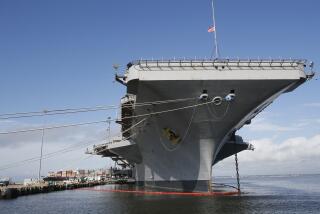Last-Minute Ship Contract Blocked Action by Clinton : Military: Bush Administration deal swept aside objections about builder’s cost overruns, mismanagement.
- Share via
The Navy, acting at the eleventh-hour of the George Bush Administration, awarded a $365-million contract for a supply ship in an effort to preclude President Clinton from blocking or delaying the controversial and troubled program.
Just two business days before Bush left office, the Navy awarded the contract to the National Steel & Shipbuilding Co. (NASSCO) in San Diego to build the AOE-10, the fourth and last in a series.
The award swept aside congressional objections about cost overruns and mismanagement at NASSCO, as well as concerns raised by the Pentagon’s inspector general that the Navy might not need another supply ship if the Clinton Administration carried through with its intention to cut the Navy fleet.
In a recent memorandum to Secretary of Defense Les Aspin, the inspector general asserted that the Navy’s contract award “was inappropriate and done to preclude giving you (Aspin) the option of considering the ship acquisition during the new Administration budget review.”
Navy spokesmen declined to comment. But a shipyard executive defended the award, saying that it had been planned for nearly a year.
The AOE-10 is critical to the struggling shipyard, which employs 3,700 workers. Rep. Julian C. Dixon (D-Los Angeles), a member of important House defense appropriations subcommittee, said the panel had strongly backed the Navy’s decision.
The action by the Navy was the focus of a furious last-minute battle that pitted it against the General Accounting Office, the watchdog arm of Congress, and the Pentagon inspector general.
On Jan. 11, shortly before the end of the Bush Administration, the GAO asked the Navy to drop its plan to issue the ship contract, citing mismanagement by NASSCO, cost growth on the program and the risk of technical problems.
On Jan. 14, the inspector general’s office, which had been advocating a cancellation of theAOE-10 for more than a year, also tried to stop the contract.
On Jan. 15, the final day of work for most Bush appointees and just before a three-day holiday weekend, the Navy issued the contract. Clinton was inaugurated Jan. 20.
The shipbuilding program had been controversial virtually from its start in 1987. The Navy in 1989 released the previous owner of NASSCO, Idaho-based Morrison Knudsen, from a written guarantee that it would pay for cost overruns. That issue is under investigation by the House Government Operations Committee.
According to internal Navy documents obtained by The Times, the program is about two years behind schedule and has incurred cost overruns borne by taxpayers of $677 million--an increase of 72% from the original estimate, not including the cost of inflation.
The company also has begun incurring additional losses, a recent defense audit found. In the past, NASSCO has shifted the burden of those losses onto the government by filing claims that fixed the blame on the government. But federal audits of the NASSCO shipyard have found a wide range of problems, including weak internal cost controls, an inadequate timekeeping system and ineffective management.
Fred Hallett, NASSCO vice president, said the shipyard has struggled with the program, but that the first ship recently performed magnificently in sea trials. He added that even with a sharp reduction in its fleet, the Navy will need the AOE-10 because the ship will be able to supply aircraft carriers while at full speed.
Despite NASSCO’s problems, the GAO probably never had much chance of stopping the award, according to the memo.
Donald Yockey, undersecretary of defense for acquisition and a Bush appointee, had given approval for the Navy to issue the contract and the defense comptroller had released the money to the Navy, the memo said.
In an interview Thursday, Yockey said he could not recall many details without consulting his notes, which he said he did not have.
But Yockey said the quick award was made out of concern that the change of administration would hold up the program because Clinton had not named an immediate successor as Navy secretary.
According to Yockey, the need for the ship had been determined by the Joint Chiefs of Staff and Congress had appropriated the funds for the ship--all routine steps that cleared the Navy to issue the contract.
“They just did what they normally do,” he said.
Asked about the inspector general’s report, Yockey said: “I don’t recall seeing anything specific on this from the inspector general.”
The memo, authored by Derek Vander Schaaf, deputy inspector general, said the contract should have been stopped because it seemed to conflict with the plans of the Clinton Administration.
“It was my position, in light of your previously stated views concerning the number of (Navy) battle groups, the acquisition decision should be reviewed by you before the contract was awarded,” Vander Schaaf wrote. “We believe the half-billion-dollar cost of the AOE-10 should be one of the items on the table for consideration during the budget reduction drill.”
Last week, Aspin submitted his first budget to Congress, calling for the retirement of 28 ships and one aircraft carrier battle group. An important role for the AOE-class ships is to supply oil, ammunition and food to carrier battle groups.
So far, the Pentagon has not changed its plans to go forward with the AOE-10, a Navy spokesman said Thursday. The contract can be canceled, but the Pentagon would incur stiff financial penalties if it did so.
In San Diego, the first ship is so far behind schedule that the Navy was recently forced to hire a firm to scrape the barnacles off the ship’s hull, even though it has not yet been deployed.
More to Read
Inside the business of entertainment
The Wide Shot brings you news, analysis and insights on everything from streaming wars to production — and what it all means for the future.
You may occasionally receive promotional content from the Los Angeles Times.











